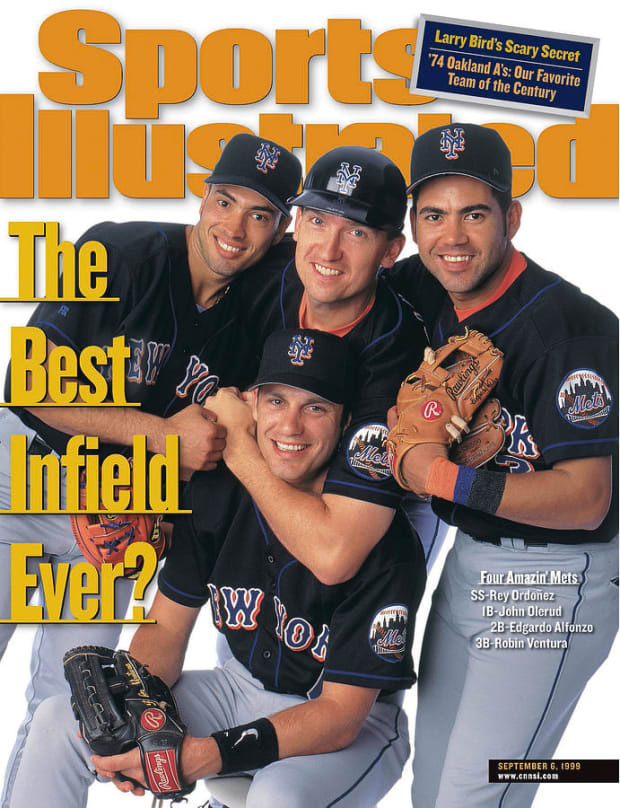Good morning, I’m Kevin Sweeney. The Cavaliers are fun again. Enjoy the long weekend, and we’ll be back in your inbox Tuesday.
In today’s SI:AM:
💼 College Football’s Most Powerful Man
If you're reading this on SI.com, you can sign up to get this free newsletter in your inbox each weekday at SI.com/newsletters.
Takeaways from CFB’s Week 1
A full first weekend of college football is officially in the books after Clemson’s 41–10 win over Georgia Tech last night. Five straight nights of games is always fun, and we had chaos that only college football can provide in many cases. From blowouts like Georgia’s big win over Oregon to chaotic finishes like ones in the Backyard Brawl on Thursday night and in LSU vs. Florida State on Sunday, here are some takeaways from the first full weekend of the season.
Brian Kelly and LSU have work to do.
Sunday night’s clash between LSU vs. Florida State in New Orleans was the perfect standalone game after a full day of games Saturday. It was not, however, the perfect start to the Brian Kelly era in Baton Rouge, as the Tigers looked sloppy and undisciplined in the season-opening defeat.
A quick list of some of the blunders that hurt the Tigers:
- Two muffed punts, including one late in the fourth that should have cost LSU the game.
- A blocked field goal.
- A senseless late hit by star defensive end Ali Gaye that led to his ejection.
- Dropped passes (and plenty of pouting) from star receiver Kayshon Boutte.
- A blocked game-tying extra point attempt on the final play of the game after the Tigers went 99 yards to miraculously set up a chance for overtime.
The major appeal of Kelly as a candidate for the LSU vacancy was bringing more organization and a more business-like approach to the program. Instead, the Tigers looked far too similar to the LSU teams of the past two seasons under Ed Orgeron. They shot themselves in the foot with unforced errors in the kicking game and arguably their best player on each side of the ball turned in head-scratching performances. This could be a long year in Baton Rouge.
Florida won a thriller.
Billy Napier opened his tenure at Florida with a huge win over No. 7 Utah under the lights in Gainesville. It was a performance so impressive that Ross Dellenger moved the Gators into his top 10 after just one week.
This game really picked up in the second half, when both teams’ offenses took over. Utah couldn’t slow down dynamic Gators QB Anthony Richardson, who impressed with both his arm and his legs on the big stage. But Florida couldn’t do much to hold off the Utes’ balanced attack, which led to an incredible closing sequence. The teams traded four consecutive touchdown drives in the second half, and it appeared the Utes would punch one more in to win the game in the final minute before Amari Burney stepped in front of Cam Rising’s pass to the end zone for a game-winning interception. It’s a huge loss for a Utah program with high expectations this season. Between the Utes’ loss in Gainesville and Oregon’s ugly defeat at the hands of Georgia, things didn't go well for the Pac-12 in Week 1.
It took a while, but Ohio State finally got going.
The talk all offseason was about just how dominant Ohio State’s offense could be. With an elite quarterback, an incredibly gifted group of receivers and a physical running back, the embarrassment of offensive riches on the OSU sideline put some high expectations on coach Ryan Day.
Instead, the path to winning in Week 1 wasn’t as exciting. Notre Dame’s defense did just about everything it could to slow down the Buckeyes’ attack, even if they were aided by a first-half injury to explosive receiver Jaxon Smith-Njigba. Ohio State was eventually able to wear down the Irish with its running game and efficient work from quarterback C.J. Stroud; the 21–10 win should give OSU some confidence. Still, it’s hard not to be impressed with the Notre Dame defense in the first true test for Marcus Freeman as the coach in South Bend.
The best of Sports Illustrated

Andy Lyons/Getty Images
In today’s Daily Cover, Pat Forde profiles SEC commissioner Greg Sankey, the most powerful man in college athletics.
Greg Sankey, now 58, has driven himself a long way. A lifetime of decisions, some of them difficult, led him away from upstate New York and culminated in commissionership of the most successful athletic conference in the nation. Since then, he has evolved into the most powerful person in his line of work, at a moment of acute fragility within the enterprise. But as his league swells in numbers, lines its coffers with cash and helps destabilize the national landscape, it’s fair to ask: Is the smartest guy in every room and on every committee now piloting college sports along the best path, or the road to ruin?
It’s game week in the NFL, and Albert Breer leads his MMQB column with thoughts on Joe Burrow, whose ability to process the game has been the separating factor that has made him into an elite QB. … Tom Verducci analyzes the historic nature of Jacob deGrom’s dominance and breaks down why the MLB’s postseason schedule makes winning the NL East imperative for the Mets to maximize their ace. … Plus, Nick Selbe’s latest power rankings explain why the Mariners are on the verge of ending a long playoff drought.
SI has also launched a sports business podcast called The Bag. Former NFL running back Rashad Jennings and sports journalist Lindsay McCormick have teamed up to make the increasingly confusing world of megacontracts, NFTs and sports betting more interesting and understandable for you. Check it out on your favorite podcast platform. The first episode features former NFL linebacker Shawne Merriman as a guest.
Around the sports world
Frances Tiafoe stunned Rafael Nadal in four sets at the U.S. Open to earn the biggest win of his career and give Nadal his first loss at a Grand Slam this year. … And on the women’s side, top-seeded Iga Świątek rallied after trailing by a set and a break to advance to the quarterfinals. … The Cowboys bolstered their offensive line depth by adding Jason Peters in an attempt to soften the blow of losing Tyron Smith to injury. … Plus, Aaron Judge inched closer to 61 homers with another blast as the Yankees beat the Twins in the Bronx.
The top five...
… things I saw this holiday weekend:
5. This insane bicycle kick goal.
4. Albert Pujols’s 695th homer… in his final at bat vs. the Cubs.
3. Serena Williams’s weekend plans.
2. Frances Tiafoe’s emotional reaction to knocking off Nadal.
1. Crazy college football radio calls like this and this.
SIQ
American Frances Tiafoe beat 22-time Grand Slam champion Rafael Nadal in four sets yesterday to make his first U.S. Open singles quarterfinal. It was the first time Nadal has lost to an American man at any stage in a major since 2005. Who was that U.S. player?
- Andy Roddick
- James Blake
- Andre Agassi
- Robby Ginepri
Check tomorrow’s newsletter for the answer.
Friday’s SIQ: Around this date in 490 B.C.E. (the exact day is tricky to figure out), Pheidippides is said to have run from Marathon to Athens, providing the inspiration for the 26.2-mile race. After the first modern Olympic marathon in 1896, which city became the first to start holding an annual marathon?
- Athens
- Boston
- London
- Chicago
Answer: Boston. John Graham, a member of the Boston Athletic Association, had been the manager for the U.S. Olympic team and was inspired by what the BAA describes as “the spirit and majesty” of the first Olympic marathon to bring the long-distance race to the United States.
The first Boston Marathon was held April 19, 1897, beginning in the town of Ashland (through which the marathon still passes today) and ending with a lap around a track near the modern finish line.
The weird thing about those early marathons is that the distances were not standardized. Because Pheidippides (if he even was a real guy) is said to have died after completing the run, he couldn’t tell anyone the route he took and just how long it was. The first Olympic marathon was about 25 miles. Graham’s original Boston marathon course was 24.5 miles. The 26.219-mile distance of the 1908 Olympic marathon became the standard and, in 1924, the BAA started using that distance as well.
—Dan Gartland
From the Vault: Sept. 6, 1999

V.J. Lovero/Sports Illustrated
By September 1999, the Mets were playing some impressive baseball. In June, July and August, the team combined for a record of 53–29. But as September rolled around, they still found themselves a few games back of NL East–leading Atlanta.
Ultimately, though, that didn’t matter. The Mets were on track to make the playoffs for the first time in 11 years, thanks in large part to “infield defense that’s tighter than a mason jar,” Tom Verducci wrote.
When New York added third baseman Robin Ventura, it solidified an infield that also included John Olerud at first, Edgardo Alfonzo at second and Rey Ordóñez at short.
Ventura added more than just fielding prowess to this Mets club, but also a personality that pushed his teammates, according to Verducci.
On a hot day in June, for instance, Ventura noticed that the Mets seemed lethargic. At the end of one inning, he walked slowly off the diamond, allowing his teammates to pass him on their way back to the cool shade of the dugout. Suddenly, Ventura burst into a sprint and made a hard slide just outside the dugout, showering the bench with dust and dirt. “Wake up!” he yelled. “Let’s go get ’em!”
The Mets ended up making the playoffs in 1999, losing to Atlanta in six games and then made it again in 2000, falling to the Yankees in the World Series. Since then, the Mets have made the playoffs just three times in 15 seasons.
But they’re on track to make some noise this season as they’re holding off Atlanta for the top spot in the NL East. This version of the club is built quite differently than the 1999 version. According to FanGraphs, the Mets are a below-average defensive team (17th in defensive runs saved) this season but use the league’s third-best on-base percentage to score enough runs to take advantage of one of baseball’s best pitching staffs.
—Josh Rosenblat
Check out more of SI’s archives and historic images at vault.si.com.







